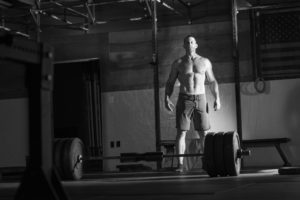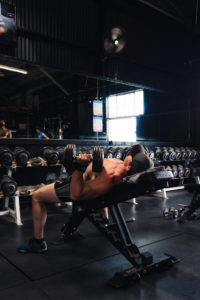AMRAP 20 min:
8 Toes to Bar
10 DB Hang Clean to Overhead (5 per arm, 50/35#)
14/12 Cal Row (male/female)
This is a workout you can do multiple times. It’s just “cardio.” Whatever your pace is, pick your pace. Want to try to hold 2-minute rounds? That’ll be a decent score, 10 rounds, right? Then force yourself to take the full 2 minutes to complete the first round. This might seem slow at first, but it might seem really fast at the end. If you are wrong, and you picked a pace too easy, then start going faster at the 10-min mark. Ultimately, your performance will be enhanced and you will feel better throughout the workout if you start at a slower pace.
Initial Preparation Concerns:
The warm-up should consist of “general warm-up” to get a light sweat going. Ideally, this should be done on the rower, since we will want to gently start to warm-up the grip, without fatiguing the grip significantly. As you progress through the rowing warm-up, start incorporating some faster intervals. It’s important to get your heart rate elevated by completing some intense “intervals” for 20-30 sec on the rower. This will prepare the body for the work ahead.
Next, you will need to do a bit more specific warm-up. The first step would be to loosen up the shoulder girdle. Include some Band Pull-Aparts, Face Pulls and Dislocates (PVC pipe pass-throughs). Then move on to some short-duration dead hangs from the pull-up bar. Switch between engaging the lats, and letting the lats hang loose (scap pull-ups), but do not spend more than 15 seconds unbroken on the bar, or this will begin to fatigue the grip. Roll out the T-spine. Do some explosive hip drills, such as knee jumps, broad jumps, high jumps etc…
The next step is to really dial in that overhead position. Start with an empty Dumbbell, and just lock it out overhead for 30 seconds. Feel the body reaching from the lats, and that the DB is supported by your entire body, and not just by your shoulders. Complete a couple reps of strict press, push press and push jerk with the light dumbbell. Try some overhead squats with the DB (hold it vertically with two hands, and try to really feel the upper scapula open up). With each rep, your mobility will open up more.
Complete a few kip swings now that the shoulder girdle is open. Find your grip and start to engage the core and hips with progressively higher leg raises. Complete small sets of 3-5 reps to protect the grip.
Finally, you will need to do a quick run through of the movements in the WOD. Not too much, because you want to stay fresh, but enough to get a sense of how you’ll feel moving between the movements.
2 Rounds (rest 2-3 min) repeat 2 Rounds
4 TTB
3 DB clean and press per arm
6 Cal Row.
Other considerations include the set-up of your equipment. Try and keep everything as linear as possible so there isn’t a whole lot of wasted movement as you transition from exercise to exercise. Try and set it up so that you can go from TTB to DB to Rower with only a few steps of transition.
Nutrition:
This workout is extremely aerobic. For the early AM workout crowd, it is best done fasted. You don’t want a ton of food and beverage moving around inside your stomach. Just make sure to eat a heaping serving of protein and carbs the night before, and you should have plenty of energy for the workout. For those that workout later in the day, the same applies. Just make sure that you don’t eat too close to the time of the workout. If you had a small portion of protein and some complex carbs (oatmeal, sweet potato) 2-3 hours prior, you should be just fine.
The Movements:
Toes to Bar
Elite athletes will be going unbroken here, but I argue that there almost nothing lost by doing quick sets of 4 reps. What might be lost in a 2-second stoppage, is regained in grip over the course of the workout. The grip fatigue is definitely the most challenging component here, so the ability to save some of this over the course of the workout is invaluable.
This workout presents the perfect opportunity for the every-day CF athlete to pace a difficult movement without losing a whole ton of time. If you can do toes to bar, but may not be able to link them consistently, this is an ideal time for singles. You MUST NOT EVER DOUBLE-KIP DANGLE (DKD). In this workout especially, the DKD will crush you. It will force you to hang on to the bar for 2x or 3x as long as you need to, and you will continue to struggle with the grip the entire workout. Quick singles are efficient. Drop from the bar, go right back up. Get a big kip each rep, and don’t miss reps or cause unnecessary grip fatigue!
DB Hang Clean to Overhead
A new movement in the CrossFit world; a similar effect on the body as the DB snatch. The fatigue, and mechanism to generate momentum will feel similar to the snatch, as well. The difference is that you will be completing 5 reps with one arm, and then 5 reps with the other arm (as opposed to alternating arms).
The most efficient method here is to pull vertically, almost like a big shrug and high pull/hammer curl with momentum. The key is to make sure you are generating power from the hips and avoid using the biceps as much as possible. Catch the DB in a slight dip, and immediately press overhead. As fatigue sets in, some athletes may need to revert to a kettlebell swing type motion to get to the shoulder.
Elite athletes will need to complete both arms without dropping the DB. The average gym goer will need to complete all reps on each arm unbroken, but it is ok to take a short rest between hands as a means of keeping a sustainable pace throughout the workout.
Calorie Row
This is your opportunity to “recover.” Loosen your grip on the handle, and force your legs to do the majority of the work. The pacing part of the row is vital and will set the tone for the pace of the entire workout. You must avoid rowing your first round at a pace that is faster than your comfort zone. You must be able to get off the rower and immediately get onto the toes to bar. If you get off the rower and stare at the bar, it means you went too hard.
I recommend a lower damper setting (3-4 range) and to keep a consistent movement on the rower. This fits into the pacing component of the workout, where we want to keep a steady rate of breathing throughout the entirety of it. If you fall into the trap of using a high damper setting and taking big heaping strokes with a long recovery, you begin to turn this workout into something anaerobic, and that is not the goal.
Overall, the name of the game for 18.1 is PACING. Find a sustainable pace, and do your best to maintain it throughout the entire workout. Good Luck!
Good luck!




